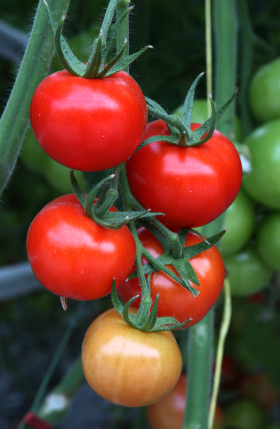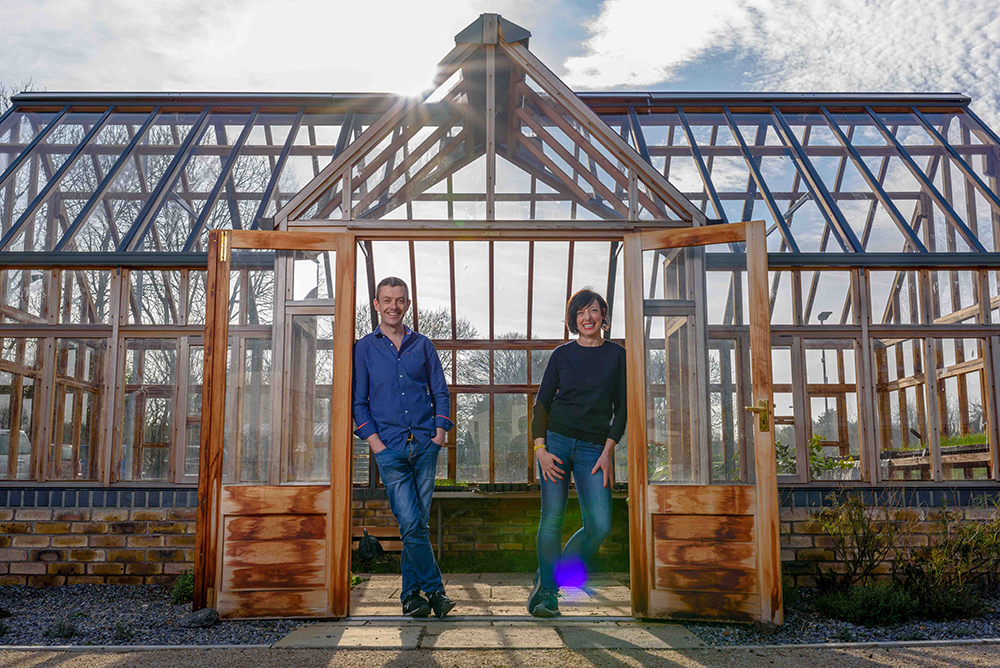Grow it Yourself
Tomato Mania
 I delivered a course on growing tomatoes at GROW HQ recently, and though I was ostensibly ‘at work’, it didn’t really feel like work to be teaching about growing tomatoes (don’t tell anyone though). For me, growing tomatoes is a hobby that became an obsession and then spiralled out of control in to a mania. It started with a tomato plant in a pot maybe 15 years ago, then became 20 plants in a small polytunnel in the garden before finally morphing in to a full scale production in a large polytunnel in a field beside the house. In year one with the big polytunnel I grew 40 plants but this became 75 plants last year. And who knows, for this year, if I can squeeze in 100 plants, I probably will. “So you must be selling all those tomatoes then”, people say. “Nope,” I respond. “They’re just for ourselves”.
I delivered a course on growing tomatoes at GROW HQ recently, and though I was ostensibly ‘at work’, it didn’t really feel like work to be teaching about growing tomatoes (don’t tell anyone though). For me, growing tomatoes is a hobby that became an obsession and then spiralled out of control in to a mania. It started with a tomato plant in a pot maybe 15 years ago, then became 20 plants in a small polytunnel in the garden before finally morphing in to a full scale production in a large polytunnel in a field beside the house. In year one with the big polytunnel I grew 40 plants but this became 75 plants last year. And who knows, for this year, if I can squeeze in 100 plants, I probably will. “So you must be selling all those tomatoes then”, people say. “Nope,” I respond. “They’re just for ourselves”.
See the thing is, growing tomatoes is a double edged sword, because once you’ve tasted a proper homegrown tomato, eaten warm in the moment it’s picked, you really can’t go back to the bland shop-bought Dutch alternative. That means that we only eat tomatoes fresh between July and October (or November if we can encourage the ever-reliable Sungold to continue cropping) and then switch to frozen passata sauces to give us that tomatoey hit from November onwards. Then it becomes a simple maths exercise. The more tomatoes you grow, the longer you get to enjoy the passata in pizzas, pastas, stews, casseroles and soups. Let me say this: at the end of March we had about half a dozen bags of sauce left in the freezer. That looming shortage comes at a bad time - just as I’m planning how many plants I’m going to grow in the year ahead. And already I’m wondering can I make the passatas last in to April or May next year, if I grow more plants?
There are lots of veggies that are a cinch to grow. Tomatoes aren’t one of them. They have a very long growing season that stretches all the way from February or March right up to October/November. During that timeframe they are demanding. Sowing, transplanting, planting out, sideshooting, watering, feeding, harvesting. When you grow them at any sort of scale, that can mean a lot of hard work. But whether you grow one plant or 100, boy are they worth it. Bear in mind that from a single tiny seed sown on a cold February day, a healthy tomato plant can grow up to 8-10ft tall and produce over 300 delicious tomatoes in a season. And that’s the payback: each of those tomatoes will taste like nothing you’ve ever eaten before.
The Basics – Sowing Direct or Transplanting?
We are often asked whether it is better to sow direct into the soil or in pots and trays (for planting out later). It's always a tough question to answer because it depends on the vegetable and there are also other variables. Sowing direct is far less time consuming, but there are risks involved (tiny seedlings being eaten by slugs etc).
Root crops such as carrots and parsnips are better sown direct, because they don't transplant so well. Vegetables with large seeds such as peas and beans are generally sown direct - you can sow in pots earlier in the season if it's too cold to sow outside directly. Onions, garlic and potatoes are all best sown direct.
I think that most other vegetables are better sown in modular or cell trays. The seedlings can then be transplanted into the prepared bed or potted on into bigger pots. This has the added advantage that those well established small plants are more resistant to slug attacks.
You can buy different types of plastic or polystyrene trays or you can recycle yoghurt pots and cut milk cartoons for use as home-made seed trays.

*** See Michael Kelly and GIY Head of Community Development, Karen O' Donohoe on GROW COOK EAT, Wednesday at 8.30pm on RTE1 - and join in the online conversation using #GROWCOOKEAT
 RECIPE: Spicy Carrot And Chickpea Pitta Pocket
RECIPE: Spicy Carrot And Chickpea Pitta Pocket
As the hungry gap really starts to kick in, and the range of veg available from the garden narrows, I’m on the hunt for recipes that use a single veg and some store cupboard ingredients to good effect. This is a great example from River Cottage Veg Every Day, using up some of our remaining carrots for a lovely light supper or lunch. I used a sourdough bread instead of the pitta bread, spreading a little yoghurt instead of butter and heaping the carrot mix on top. You can also add a little crushed cumin seed to the yoghurt for an added kick. Delicious.
Ingredients
50g butter
1 tablespoon rapeseed or olive oil
1 heaped teaspoon cumin seeds
4 large carrots (about 500g), peeled and cut into 2–3mm thick slices
1 large garlic clove, finely sliced
Finely grated zest of 1 orange, plus a good squeeze of juice
1 teaspoon hot smoked paprika
400g tin chickpeas, drained and rinsed
4 pitta breads or freshly cooked, soft flatbreads
4 heaped tablespoons plain (full-fat) yoghurt or soured cream
Sea salt and freshly ground black pepper
Directions
Heat the butter and oil in a frying pan over a medium heat. Add the cumin seeds and let them fry for a minute or two. Add the carrots and fry for about 8–10 minutes, stirring often, until tender and starting to brown, but still with some bite.
Add the garlic, orange zest, paprika and chickpeas and cook until the chickpeas are hot. Remove from the heat, season with salt and pepper and add a good squeeze of orange juice. Taste and add more salt, pepper and/or orange juice as needed.
Spoon some of the chickpea mixture into the pocket of a warmed pitta (or into the middle of each flatbread) and top with a spoonful of yoghurt or cream. Fold flatbreads, if using. Serve straight away.
Michael Kelly is an author, broadcaster and founder of GIY
© GIY Ireland 2019 – all rights reserved.






There are currently no comments
Leave a comment
Not a member? Register for your free membership now!
Or leave a comment by logging in with: